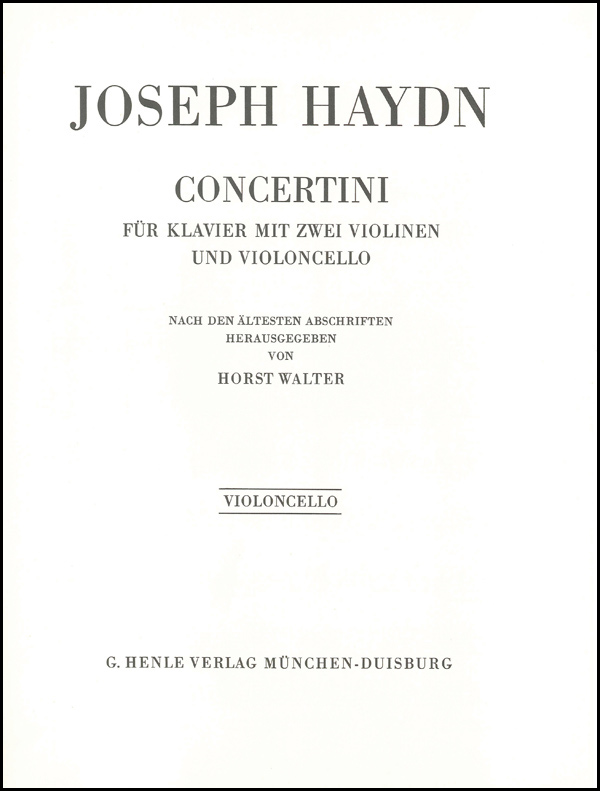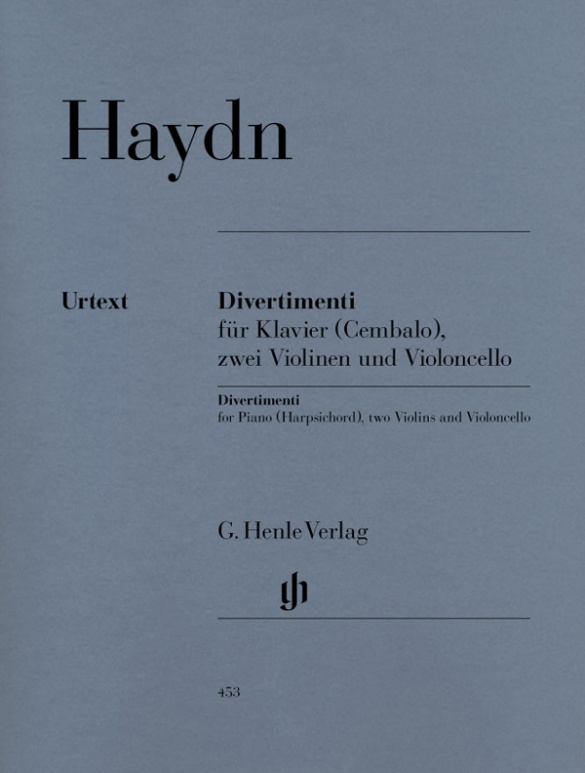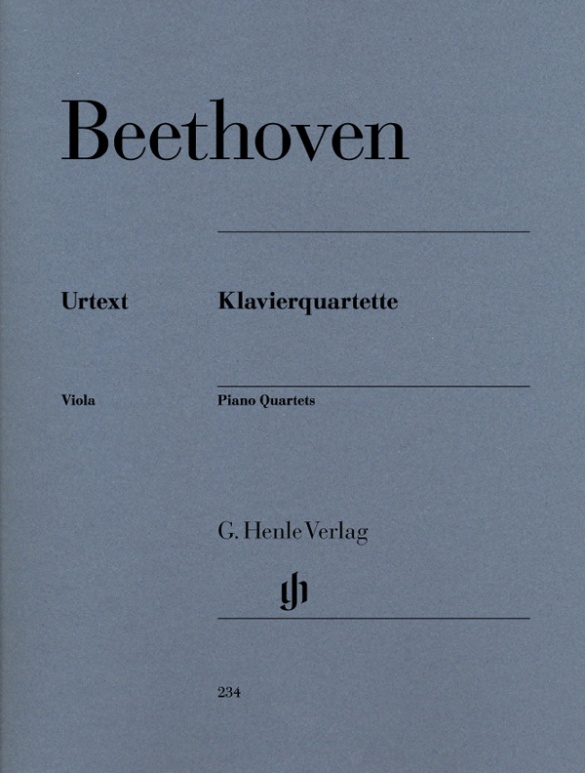Joseph Haydn
Concertini pour piano (clavecin) avec deux violons et violoncelle
CONTENU/DÉTAILS
(Explanation)
CONCERNANT LE COMPOSITEUR
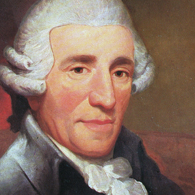
Joseph Haydn
Son œuvre immense documente le changement fondamental dans l’histoire de la musique qui s’opère au cours de la seconde moitié du XVIIIe s. et qui conduit à l’émancipation de la musique instrumentale. Les genres où il s’est principalement illustré sont la symphonie et le quatuor à cordes dans lesquels il a développé le procédé de l’élaboration des motifs et des thèmes; il est l’auteur d’importantes contributions pour le concert instrumental et la musique pour piano; ses grands oratorios virent le jour au cours des dernières années de sa vie. L’opéra et le lied sont plutôt sous-représentés.
| 1732 | Il est probablement né le 31 mars à Rohrau (baptisé le 1er avril). |
| 1737 | ou 1738 Son oncle Johann Mathias Franck le prend chez lui pour diriger sa formation musicale. |
| vers 1739/40 | Enfant de chœur à la cathédrale Saint-Étienne de Vienne durant environ 8 à 10 ans. |
| à partir de 1750 | Il gagne sa vie en tant que musicien, enseignant et compositeur. |
| 1757–61 | Engagé en tant que directeur de la musique chez le comte Morzin. Il se fait un nom en tant que compositeur: 15 symphonies, sonates pour piano, trios, divertimentos, à trios cordes, partitas pour vents, quatuors à cordes op. 1 et 2. |
| 1761 | Symphonies «des Heures du jour» n° 6-8: «Le matin», «Le midi», «Le soir». |
| à partir de 1761 | Engagé à la cour d’Esterházy sous le prince Paul Anton, à partir de 1762 sous le prince Nicolas, 1790-96 sous Paul Anton II, puis sous Nicolas II, tout d’abord vice-maître de chapelle, puis maître de chapelle en titre à partir de 1766. |
| 1764–65 | Symphonies n° 22 en Mi bémol majeur «Le Philosophe», n° 30 en Ut majeur («Alleluia»), n° 31 en Ré majeur («Sonnerie de cor»). |
| 1766 | Le prince Nicolas Esterházy commande des opéras pour le théâtre du nouveau château. Haydn compose essentiellement ses opéras pour des circonstances particulières, p. ex. «La Canterina» en 1766 pour la visite de l’Empereur. Il compose à plusieurs reprises des pièces pour baryton pour le prince Nicolas. |
| 1766–74 | 18 symphonies, parmi lesquelles «La passione» en Fa mineur (1768), «Lamentazione» en Ré mineur (1770), «Le Maître d’école» en Mi bémol majeur (1774), la «Symphonie funèbre» en Mi mineur (1772): un spectre expressif élargi (6 sont en mineur), davantage de contrepoint. |
| 1768 | Création de «Lo speziale» sur un livret de Goldoni pour l’inauguration du nouveau théâtre lyrique à Eszterháza. |
| 1770 | Création du dramma giocoso «Le pescatrici» (Les Pêcheuses). Après une interruption de dix ans, il écrit les novateurs «6 Divertimenti» pour quatuor à cordes op. 9 et op. 17 (1771). |
| 1771 | Sonate pour piano n° 20 en Ut mineur. |
| 1772 | Symphonie «des Adieux» n° 45 en Fa dièse mineur; «6 Divertimenti» (quatuors «du soleil») op. 20, marqués par l’écriture contrapuntique (parfois derniers mouvements en forme de fugues). |
| 1775 | Création de l’opéra «L’incontro improvviso» (La rencontre imprévue). |
| vers 1775–78 | «Missa brevis sancti Joannis de Deo (“petite messe pour orgue”)». |
| 1776 | Le prince Nicolas commande régulièrement des opéras à Eszterháza. Haydn arrange les œuvres importées de Vienne ou d’Italie pour les mettre au goût local. Il quitte Eisenstadt pour s’installer au château d’Eszterháza où la cour séjourne durant 10 mois par an. Peu de musique instrumentale après 1776, souvent avec intégration de musique d’opéra. |
| 1777 | Création de «Il mondo della luna» d’après Goldoni. |
| 1779 | Contact avec l’éditeur Artaria qui assure la diffusion de ses œuvres au cours de la décennie suivante. |
| 1781 | Exécution de l’opéra «La Fedeltà premiata» (La Fidélité récompensée). Messe «de Mariazell»; Quatuors à cordes op. 33 («Quatuors russes») qui, après une assez longue interruption dans la composition de quatuor, sont écrits «dans une manière toute nouvelle et particulière» (Haydn). Ils passent pour emblématiques de l’«humour» haydnien dans la mise en œuvre ludique des ressources. |
| 1782 | Création de «Orlando paladino». Il commence aussi à vendre ses compositions à l’étranger: il fait imprimer à Paris les symphonies n° 76-78 et 79-81 (1783-84). |
| 1783 | Concerto pour violoncelle en Ré majeur (Hob. VIIb:2). |
| 1784 | Création d’«Armide»; puis il ne compose plus d’opéras pour la cour. Concerto pour piano en Ré majeur. |
| 1785–86 | Commande du comte d’Ogny de 6 symphonies (Symphonies parisiennes n° 82-87) destinées au Concert de la Loge Olympique à Paris. |
| 1787–90 | Quatuors à cordes op. 50, 54 et 55. Après la mort du prince Nicolas, le prince Paul Anton II congédie l’ensemble de la chapelle de la cour. Haydn conserve officiellement son poste. |
| 1791 | Composition de l’opéra «L’anima del filosofo ossia Orfeo ed Eurudice» qui ne fut jamais exécuté (représentation posthume à Florence en 1951). |
| 1791–92 | Séjour à Londres, engagé par l’organisateur de concerts Johann Peter Salomon. «6 Quartetti» op. 64; le premier recueil d’arrangements de mélodies écossaises paraît en 1792. Composition des six premières Symphonies londoniennes (n° 93-98), parmi lesquelles la Symphonie «La Surprise» n° 94. |
| 1792 | Sinfonia concertante pour violon, violoncelle, hautbois, basson et orchestre en Si bémol majeur. |
| 1794–95 | Second séjour à Londres. 6 Symphonies londoniennes n° 99-104, n° 104 avec un premier mouvement monothématique, Symphonie n° 100 («La militaire») intégrant de la musique de janissaires; rondo de sonate comme nouvelle forme de mouvement final, p. ex. n° 102. |
| 1794 | Début du règne de Nicolas II qui commande chaque année une messe pour la fête de la princesse. Six grandes messes voient le jour: «Heiligmesse» (M. à saint Bernard) en Si bémol majeur et «Paukenmesse» (M. au roulement de timbales) en Ut majeur (1796), «Nelsonmesse» en Ré mineur / Ré majeur (1798), «Theresienmesse» en Si bémol majeur (1799), «Schöpfungsmesse» (M. de la Création) en Si bémol majeur (1801), «Harmoniemesse» en Si bémol majeur (1802). |
| 1796 | Version vocale de la composition tout d’abord instrumentale des «Sept paroles du Christ sur la croix», Concerto pour trompette en Mi bémol majeur. |
| 1797 | Hymne impérial «Gott erhalte Franz den Kaiser» et Quatuor de l’Empereur en Ut majeur op. 76/3. |
| 1798 | Création de l’oratorio «La Création». |
| 1801 | Création de l’oratorio «Les Saisons». |
| 1809 | Meurt le 31 mai à Vienne. |
About the Authors
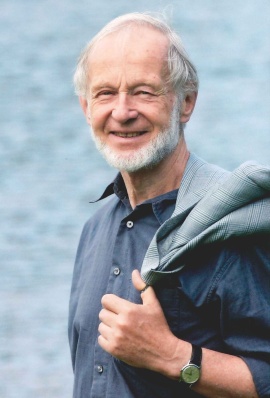
Horst Walter (Editeur)
Dr. Horst Walter, born in 1931 in Hannover, studied musicology, German and philosophy at the University of Cologne. In 1962 he completed his doctorate with a thesis on the musical history of Lüneburg and that same year became a research associate at the Joseph Haydn-Institut.
From 1992 until his retirement he was its Head. He made numerous contributions to Haydn research, including articles of a biographical documentary and bibliographic nature. Horst Walter died on 4 April 2016.
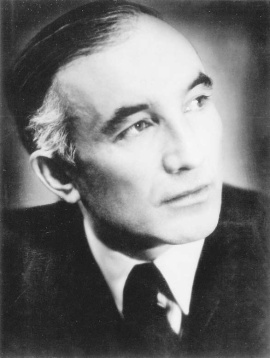
Hans-Martin Theopold (Doigtés)
Prof. Hans-Martin Theopold, was born to a pastor’s family in Detmold on 22 April 1904, the youngest of five children. Even as a child he often played the organ in the “Marktkirche” and soon began to take piano lessons with Theodor Vehmeier. At the age of 17 he made his debut at the Landestheater in Detmold with Ludwig van Beethoven’s Piano Concerto in C major under Friedrich Quast (Herford). Following the successful completion of his schooling at the Gymnasium Leopoldinum in Detmold, he went on to study music and piano (main subject): from 1922–23 at the “Württembergische Hochschule für Musik” in Stuttgart (with Max Pauer, 1866–1945) and then from 1923–1928 at the “Staatliche Akademische Hochschule für Musik” in Berlin-Charlottenburg (with Richard Rössler, 1880–1962, and Waldemar Lütschg, 1877–1948). After completing his piano studies (graduating with “very good”) in 1928, he began an active solo career both at home and abroad (USA, Switzerland, Scandinavia, the Baltic states, the Balkans). As a member of the Chamber Music Association of the State Opera in Berlin (from 1933) he also gave countless chamber music concerts, including ones with his violin partner Gustav Havemann (1882–1960).
In the 1930s, audiences and the press alike raved about Theopold’s extraordinary gifts as a pianist: “This young player has it in him to soon become one of the best players in Germany. A superior technique, a wonderful singing piano tone, the strength of a Titan, but not at all hard due to the incomparably gentle elasticity of his touch” [Münchener Zeitung, 21 November 1933]. – “H.M. Theopold gave convincing proof of his splendid pianistic ability in an extremely gripping sonata with a modern idiom by Alban Berg, but predominantly in Schubert’s […] Wanderer Fantasy, which he played with a polished technique and creative power” [Weser-Zeitung, 21 December 1932]. Theopold was awarded several prizes, including the “Grotrian-Steinweg-Preis” in 1928.
In 1937 Theopold became a teacher for the piano (main subject) at the “Bayerisches Staatskonservatorium der Musik” in Würzburg. In 1939 he married Irene Tatjana Wülfing, who was from Moscow. From 1943 he became head of the piano master-class at the “Nordische Musikschule” in Bremen, although this was interrupted by the events of the war. Following his return from a prisoner of war camp, Theopold gave concerts and taught although he did not hold a permanent position. From 1955–1956 he was acting head of the piano master-class at the “Bergisches Landeskonservatorium” in Wuppertal, finally being appointed Professor for Piano on 1 April 1956 at the “Staatliches Institut für Schul- und Volksmusik” in Detmold, later at the “Nordwestdeutsche Musikakademie Detmold” (today “Hochschule für Musik Detmold”), where he taught for decades. On 30 September 1969 he retired. “His students extol his pedagogical gifts. […] Humour, charm, helpfulness and kind-heartedness moderate the strictness of his professional ethos as a musician and teacher” (Lippische Rundschau, 23 April 1969; see also: Lippische Landeszeitung 22 April 1969 on the occasion of Theopold’s 65. birthday: “Prof. Theopold, a modest but at the same time energetic man, is an enthusiastic teacher”). Theopold died in Detmold in 2000.
Contact with Günter Henle was established directly after the publishing house was founded, when Theopold thanked the publishers with great enthusiasm for its first Urtext editions. His extensive correspondence with the publishing house was bequeathed to the Lippische Landesbibliothek in 2014 to ensure its long-term accessibility to the public. The letters testify not only to Theopold’s great interest in musical sources and text questions but also to his initial strict refusal (!) of fingerings in text-critical editions such as these: “For fingerings are and remain something individual no matter what their quality” (letter to Günter Henle from 26 May 1949 {publishing house archives}). Günter Henle was not, however, to be swayed and stressed the necessity of fingerings in his Urtext editions: “It is better to publish the Urtext […] with fingerings that are not necessary for a few individuals, or that might even, I admit, be considered irritating here and there” (letter to Hans-Martin Theopold of 17 September 1953).
It was only in 1955 that Theopold accepted Günter Henle’s offer of contributing fingerings for an Urtext edition that was in the process of being prepared by way of trial. (HN 74, Schubert, Complete Dances for Piano, Volume 1). Following this, Theopold was commissioned to write the fingerings for nearly all of the publishing house’s new editions in quick succession. Günter Henle, himself a good pianist, greatly valued Theopold’s fingerings, and also the many suggestions regarding the musical text in question. In addition, Theopold was always very reliable, thorough and conscientious – something that is not unimportant with editorial work!
Thus to date Hans-Martin Theopold has provided the fingerings for the greatest number of Henle Urtext editions by far – 226 editions (!) in total.
We would like to thank Mrs Margot Theopold and the Hochschule für Musik in Detmold for their great support in providing biographical material.
G. Henle Verlag
Informations sur la sécurité du produit

G. Henle Verlag
Vous trouverez ici des informations sur le fabricant du produit.G. Henle Verlag e.K.
Forstenrieder Allee 122
81476 München
Allemagne
info@henle.de
www.henle.com
recommandations
autogenerated_cross_selling
Autres éditions de ce titre


